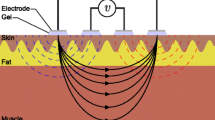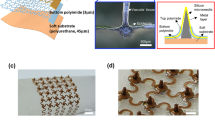Abstract
Electrical impedance myography (EIM) is a noninvasive technique for neuromuscular assessment, wherein a low-intensity alternating current is applied to a muscle, and the consequent surface voltage patterns are evaluated. Commercial wet electrodes are most commonly used for EIM. However, these electrodes are not suitable for use on small muscles, as they do not effectively solve the problem of high electrode-skin contact impedance (ESCI) that negatively influences the quality of recorded biopotentials. To address this problem, we fabricated a novel microneedle electrode array (MEA) that consists of 124-µm-long microneedles. Compared to wet electrodes, the MEA could pierce through the outer skin surface in a painless and micro-invasive manner, and could thus effectively reduce ESCI. The MEA has excellent test–retest reproducibility, with intraclass correlation coefficients exceeding 0.920. When used in combination with EIM, the MEA differentiated the affected muscles from the unaffected muscles in patients with neurogenic myopathy, by using EIM parameters of reactance and phase (p = 0.023 and 0.008, respectively). Thus, the novel MEA is a practical and reusable device for EIM assessment in cases of neurogenic myopathy. However, further refinement of the electrode is needed to enhance the clinical application of the system.








Similar content being viewed by others
Abbreviations
- EIM:
-
Electrical impedance myography
- ESCI:
-
Electrode-skin contact impedance
- MEA:
-
Microneedle electrode array
- EMG:
-
Electromyography
- SC:
-
Stratum corneum
- DRIE:
-
Deep reactive ion etching
- SEM:
-
Scanning electron microscope
References
Ahad, M., et al. Correlation between muscle electrical impedance data and standard neurophysiologic parameters after experimental neurogenic injury. Physiol. Meas. 31(11):1437–1448, 2010.
Ahad, M. A., et al. The effect of subacute denervation on the electrical anisotropy of skeletal muscle: Implications for clinical diagnostic testing. Clin. Neurophysiol. 121(6):882–886, 2010.
Baron, N., et al. Investigations of development process of high hollow beveled microneedles using a combination of ICP RIE and dicing saw. Microsyst Technol. 14(9):1475–1480, 2008.
Chandrasekaran, S., et al. Characterization of surface micromachined metallic microneedles. J. Microelectromech. Syst. 12(3):289–295, 2003.
Chin, A. B., et al. Optimizing measurement of the electrical anisotropy of muscle. Muscle Nerve. 37(5):560–565, 2008.
Hans, G. J., et al. Age- and gender-associated differences in electrical impedance values of skeletal muscle. Physiol. Meas. 34(12):1611–1622, 2013.
Havard, K., et al. Electrical Impedance of Stainless Steel Needle Electrodes. Ann. Biomed. Eng. 38(7):2371–2382, 2010.
Hsu, L. S., et al. Developing barbed microtip-based electrode arrays for biopotential measurement. Sensors. 14(7):12370–12386, 2014.
Joon, G. H., et al. Conductive microtip electrode array with variable aspect ratio using combination process of reactive ion etching. J. Micromech. Microeng. 23(11):115009, 2013.
Kochhar, J. S., et al. Direct microneedle array fabrication off a photomask to deliver collagen through skin. Pharm Res. 31(7):1724–1734, 2014.
Koehler, M. J., et al. In vivomeasurement of the human epidermal thickness in different localizations by multiphoton laser tomography. Skin Res. Technol. 16(3):259–264, 2010.
Li, J., et al. Alteration in surface muscle electrical anisotropy in the rat SOD1 model of amyotrophic lateral sclerosis. Clin. Neurophysiol. 123(1):206–210, 2012.
Mansoor, I., et al. Arrays of hollow out-of-plane microneedles made by metal electrodeposition onto solvent cast conductive polymer structures. J. Micromech. Microeng. 23(8):085011, 2013.
Miller, P. R., et al. Integrated carbon fiber electrodes within hollow polymer microneedles for transdermal electrochemical sensing. Biomicrofluidics. 5(1):013415, 2011.
Pouria, F. A review of organic and inorganic biomaterials for neural interfaces. Adv Mater. 26(12):1846–1885, 2014.
Ruffini, G., et al. A dry electrophysiology electrode using CNT arrays. Sensors Actuators A 132:34–41, 2006.
Rutkove, S. B. Electrical impedance myography: background, current state, and future directions. Muscle Nerve. 40(6):936–946, 2009.
Rutkove, S. B., et al. Electrical impedance myography to assess outcome in amyotrophic lateral sclerosis clinical trials. Clin. Neurophysiol. 118(11):2413–2418, 2007.
Rutkove, S. B., et al. Characterizing spinal muscular atrophy with electrical impedance myography. Muscle Nerve. 42(6):915–921, 2010.
Rutkove, S. B., et al. Electrical impedance myography in spinal muscular atrophy: alongitudinal study. Muscle Nerve. 45(5):642–647, 2012.
Rutkove, S. B., et al. Electrical impedance myography as a biomarker to assess ALS progression. Amyotroph Lateral Scler. 13(5):439–445, 2012.
Sang, J. M., et al. A novel fabrication method of a microneedle array using inclined deep x-ray exposure. J. Micromech. Microeng. 15(5):903, 2005.
Schwartz, S., et al. Optimizing electrical impedance myography measurements by using a multifrequency ratio: a study in Duchenne muscular dystrophy. Clin. Neurophysiol. 126(1):202–208, 2015.
Spieker, A. J., et al. Electrical impedance myography in the diagnosis of radiculopathy. Muscle Nerve. 48(5):800–805, 2013.
Tarulli, A. W., et al. Electrical impedance myography in the bedside assessment of inflammatory myopathy. Neurology. 65(3):451–452, 2005.
Tarulli, A. W., et al. Electrical impedance myography in the assessment of disuse atrophy. Arch Phys Med Rehabil. 90(10):1806–1810, 2009.
Wang, L. L., et al. Assessment of alterations in the electrical impedance of muscle after experimental nerve injury via finite element analysis. IEEE Trans. Biomed. Eng. 58(6):1585–1591, 2011.
Wang, L. L., et al. Electrical impedance myography for monitoring motor neuron loss in the SOD1 G93A amyotrophic lateral sclerosis rat. Clin. Neurophysiol. 122(12):2505–2511, 2011.
Wilke, N., et al. Process optimization and characterization of silicon microneedles fabricated by wet etch technology. Microelectron. J. 36(7):650–656, 2005.
Yan, X. X., et al. Tapered metal microneedles fabricated by the hybrid process of mechanical dicing and electrochemical corrosion for drug delivery. Micro Nano Lett. 7(12):1313–1315, 2012.
Acknowledgments
This study was supported by the National Natural Science Foundation of China (Grant No. 61376072; 61334008). The authors acknowledge the support of the Department of Neurology of the Peking Union Medical College Hospital.
Author information
Authors and Affiliations
Corresponding author
Additional information
Associate Editor Tingrui Pan oversaw the review of this article.
Rights and permissions
About this article
Cite this article
Li, Z., Li, Y., Liu, M. et al. Microneedle Electrode Array for Electrical Impedance Myography to Characterize Neurogenic Myopathy. Ann Biomed Eng 44, 1566–1575 (2016). https://doi.org/10.1007/s10439-015-1466-5
Received:
Accepted:
Published:
Issue Date:
DOI: https://doi.org/10.1007/s10439-015-1466-5




